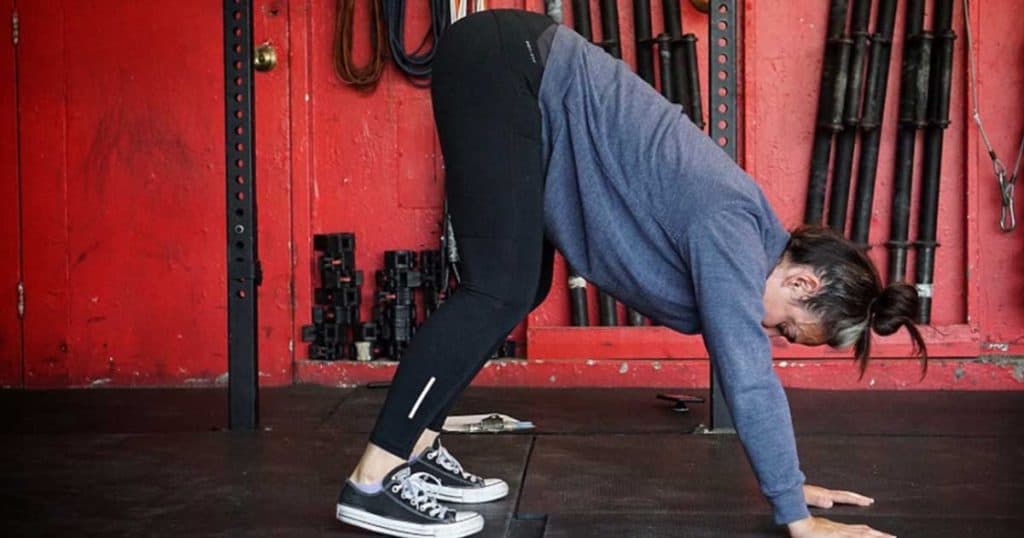5 Top Moves to Practice During Pregnancy

By Dr. Lindsey Matthews, Founder of birthfit
Squat
The squat is a full body movement. This movement not only requires adequate range of motion throughout your entire spine, pelvis, and lower extremities, but also trunk stability (aka core strength) in order to maintain an upright posture against gravity.
Compared to the lithotomy position that is commonly used in hospitals for the second stage of labor, the squat actually opens the birth canal by as much as 30%.
In general, we usually encourage our mamas to squat (with no load) daily, a minimum of 25 beautiful squats. These can be spaced out throughout the day or all in one effort. If you are training with us, either online or with someone on our team, then you know we will incorporate some variety from load to volume to different styles of squatting.
We love Ina May Gaskin’s quote, “Squat 300 times a day, you’re going to give birth quickly.” However, if you have not been squatting at all, start with our minimum of 25 squats a day.
Lunge
The lunge is one of our favorite movements because it will, without a doubt, reveal any pelvic issues or discrepancies from side to side. The lunge, just like the squat, opens up the pelvis, but more specifically on one side versus the other. The lunge, just like the squat, will build strength and enhance range of motion in the lower extremities and posterior chain.
The lunge is also a common position used in labor. So, when a mama tells me that doing lunges is uncomfortable or there is more discomfort from one side versus the other, then I know, as a doctor of chiropractic, that something is off within her pelvis and/or associated ligaments and muscles.
In general, we usually encourage our mamas to lunge (with no load) for ten reps on each, for a minimum total of 20 a day. Again, if you are training with the BIRTHFIT tribe, you know our lunges will vary from day to day.
Crawl
When we say crawl, we literally mean get down on on all fours (table top) position, and crawl around. We wrote a whole blog dedicated to crawling last summer, because some fitness trainers in this world actually think crawling will worsen the conditioning of their ab (rectus abdominis) muscles. It does not. Crawling is as innate in us as blinking.
Crawling is especially useful around weeks 25-34 when baby is starting to get in position for birth. Crawling gets baby out of the pelvis while also demanding some trunk stability from mom.
If you sit or drive a lot or work predominantly on one side of your body (dental hygienist), then, without hesitation, add five minutes of crawling to your daily movement routine.
Bear
The bear is a higher skill version of the crawl. The bear requires strength and flexibility in your posterior chain as well as shoulders and mid to upper back. Unlike downward dog, where the majority of the people will dump their bellies and chest forward, our bear position is done with a neutral spine and bent knees. Our goal is to maintain spinal neutral so that the rib cage and pelvis are stacked in line with each other. In this position, baby has the most room to move around in a semi-inverted, non-weight bearing position.
When in the bear position, we can focus on our diaphragmatic breathing or we can walk and get more of a deep core ( “ab”) workout. Just as in crawling, we prefer to see this movement incorporated into our moms’ daily movement routine for a minimum of 5 minutes.
Walk
Slow life down and go for 20-30 minute walks at least three times a week. We live in a sedentary, fast-paced, technology-enhanced world. Take time for yourself and the special spirit growing inside of you. Walking allows for movement within the lumbar spine and pelvis and associated musculature while also increasing blood flow to these structures and the organs within them (hello uterus!). Use walking as a time to slow down and connect with the present moments. We recommend not listening to music or using your phone during this walk, but rather connecting with yourself and your baby.
All the movements mentioned above are actually part of a human being’s developmental progression. These movements are innate to us, meaning these are natural movements. We actually learn many of these movements from the first few weeks of life throughout the next 18 months. If any of these movements are challenging for you, then reach out to your nearest Regional Director or BIRTHFIT Coach for support. Below are free YouTube videos of our Functional Progression (designed by Dr. Erica Boland, BIRTHFIT Wisconsin) to help mamas move throughout their motherhood transition:
Functional Progression 1
Functional Progression 2
https://www.youtube.com/watch?v=ET2ei-h6jYU&t=7s
Functional Progression 3
Functional Progression 4
https://www.youtube.com/watch?v=5d-iEXG5A6A
Move a little bit each day!
XO.
Lindsey
